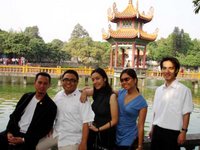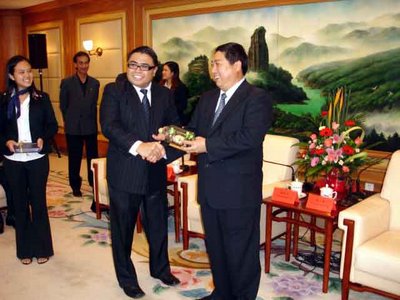 Today, we had a chance to go around Fuzhou, which is referred to as Rongcheng or the City of Banyan Trees which were planted in the city at the time of the Northern Song Dynasty (960-1127). First on our itinerary today was a visit to the Xichan Temple. Finally, after our close to a week's stay in China, we get to visit a centuries-old cultural structure. Good news for a heritage buff! Hehe! The temple was said to have been built in 867 A.D.
Today, we had a chance to go around Fuzhou, which is referred to as Rongcheng or the City of Banyan Trees which were planted in the city at the time of the Northern Song Dynasty (960-1127). First on our itinerary today was a visit to the Xichan Temple. Finally, after our close to a week's stay in China, we get to visit a centuries-old cultural structure. Good news for a heritage buff! Hehe! The temple was said to have been built in 867 A.D. According to sources, the temple is in the west of Fuzhou, on the foot of Mount Yi. An ancient temple of the Tang Dynasty (618-907), Xichan is one of five Buddhist temples in the city. The most visible structure is its tall pagoda. Another feature of the temple is the many Litchi trees, planted in the Song Dynasty (960-1279). The visit to the temple was a good opportunity for many of us to relax and enjoy Chinese heritage, and for some of us, to retreat and reflect.
According to sources, the temple is in the west of Fuzhou, on the foot of Mount Yi. An ancient temple of the Tang Dynasty (618-907), Xichan is one of five Buddhist temples in the city. The most visible structure is its tall pagoda. Another feature of the temple is the many Litchi trees, planted in the Song Dynasty (960-1279). The visit to the temple was a good opportunity for many of us to relax and enjoy Chinese heritage, and for some of us, to retreat and reflect.After the short tour, we then visited some enterprises based in Fuzhou such as the Fujian Jindeli Holdings Corporation which produces jewelry, as well as the Fujian Star-net Communications Company. Lunch was at the Rongquiao Riverview Hotel were a huge buffet awaited us. There was just too much food from the usual Chinese food, to sushi, shabu-shabu, and grilled meats. I really had to control my appetite since I didn't want to gain weight during the trip. Hehe!
 This was followed by a visit to the Ninghua Youth Civilization Community to observe volunteer work being done by the group in a community composed mostly of senior citizens. Again, the main discussion point of the camp was volunteerism and I do hope we could strengthen that here.
This was followed by a visit to the Ninghua Youth Civilization Community to observe volunteer work being done by the group in a community composed mostly of senior citizens. Again, the main discussion point of the camp was volunteerism and I do hope we could strengthen that here. Our last stop was a few minutes at the Fuzhou Riverside Park. There are just so many parks and open spaces in China. Really great for the standard of living. In Metro Manila, we only have a few open spaces left and some mayor is even attempting to chop down the last urban forest in his jurisdiction. I wonder what runs in his mind when he gets all these crazy ideas. I think mayors here should have the political will to reclaim open spaces such as old plazas and parks that used to be a highlight of Manila at the turn of the past century.
Our last stop was a few minutes at the Fuzhou Riverside Park. There are just so many parks and open spaces in China. Really great for the standard of living. In Metro Manila, we only have a few open spaces left and some mayor is even attempting to chop down the last urban forest in his jurisdiction. I wonder what runs in his mind when he gets all these crazy ideas. I think mayors here should have the political will to reclaim open spaces such as old plazas and parks that used to be a highlight of Manila at the turn of the past century. We then trooped back to the hotel to prepare for a very formal courtesy call to the leaders of Fujian province. And just to let you know, Chinese provinces are as big as countries! In fact, the Philippines is just slightly larger than Guangxi. Mainland China, with its land area of 9.5 million square kilometers just has 22 provinces, five autonomous regions and four independent municipalities. In fact, many Chinese cities are bigger than our provinces which I why I wonder where some people in Davao City got the idea that they are the biggest city in the world in terms of land area. Shanghai, China's biggest city, is a little over two times the size of Davao City at 6,340.5 square kilometers.
We then trooped back to the hotel to prepare for a very formal courtesy call to the leaders of Fujian province. And just to let you know, Chinese provinces are as big as countries! In fact, the Philippines is just slightly larger than Guangxi. Mainland China, with its land area of 9.5 million square kilometers just has 22 provinces, five autonomous regions and four independent municipalities. In fact, many Chinese cities are bigger than our provinces which I why I wonder where some people in Davao City got the idea that they are the biggest city in the world in terms of land area. Shanghai, China's biggest city, is a little over two times the size of Davao City at 6,340.5 square kilometers. Compare the China figures to the 79 provinces of the Philippines in just 300,000 square kilometers! I feel the Philippines is just too fragmented, where a few small municipalities can constitute a province. As a result, there is no coordinated development effort with each governor having his own preferences, whims and caprices and the result is a chopsuey urban landscape. In fact, as I speak, votes are being counted for the creation of the new province of Shariff Kabunsuan, the 80th province, which is almost sure of approval by Maguindanao voters. Obviously, this creates more positions up for grabs for our politicians. I feel that this practice has to be stopped and that we should be doing the opposite which is fusing together small political units to halt the chopsuey development. Oh well!
Compare the China figures to the 79 provinces of the Philippines in just 300,000 square kilometers! I feel the Philippines is just too fragmented, where a few small municipalities can constitute a province. As a result, there is no coordinated development effort with each governor having his own preferences, whims and caprices and the result is a chopsuey urban landscape. In fact, as I speak, votes are being counted for the creation of the new province of Shariff Kabunsuan, the 80th province, which is almost sure of approval by Maguindanao voters. Obviously, this creates more positions up for grabs for our politicians. I feel that this practice has to be stopped and that we should be doing the opposite which is fusing together small political units to halt the chopsuey development. Oh well! Enough with the digression. So going back, we met up with Mr. Chen Shaoyong, the Secretary-General of the Fujian Provincial Standing Committee of the Communist Party of China, the no. 2 man in Fujian.
Enough with the digression. So going back, we met up with Mr. Chen Shaoyong, the Secretary-General of the Fujian Provincial Standing Committee of the Communist Party of China, the no. 2 man in Fujian. A dinner banquet followed at another five-star hotel. I feel this banquet was the most lavish of them all since they brought out some exotic-looking dishes. Wasn't able to note down all the dishes since the menu was in Chinese.
A dinner banquet followed at another five-star hotel. I feel this banquet was the most lavish of them all since they brought out some exotic-looking dishes. Wasn't able to note down all the dishes since the menu was in Chinese.This was the last activity of the China-ASEAN Youth Camp 2006 so it served as a farewell party as well. More toasts were exchanged as a tribute to the strong cooperation among nations. To end the evening, the entire ballroom sang the Chinese and original versions of Auld Lang Syne. This song gives me the goosebumps since it was always played for our emotional farewells in the Ship for Southeast Asian Youth Program which I participated in way back in 2002.
 According to sources, the words Auld Lang Syne literally translates from the old Scottish dialect meaning Old Long Ago and is about love and friendship in times past. The part of the song which goes "We'll take a Cup of Kindness yet" relates to a drink shared by men and women to symbolise friendship. So there, a fitting finale to a week of cultural exchange between neighbors.
According to sources, the words Auld Lang Syne literally translates from the old Scottish dialect meaning Old Long Ago and is about love and friendship in times past. The part of the song which goes "We'll take a Cup of Kindness yet" relates to a drink shared by men and women to symbolise friendship. So there, a fitting finale to a week of cultural exchange between neighbors.Our great China adventure begins tomorrow. While the other delegates go back home to their own countries, three of us decided to make the most of our China trip by visiting Beijing.

No comments:
Post a Comment